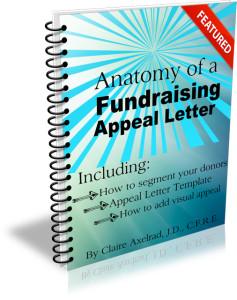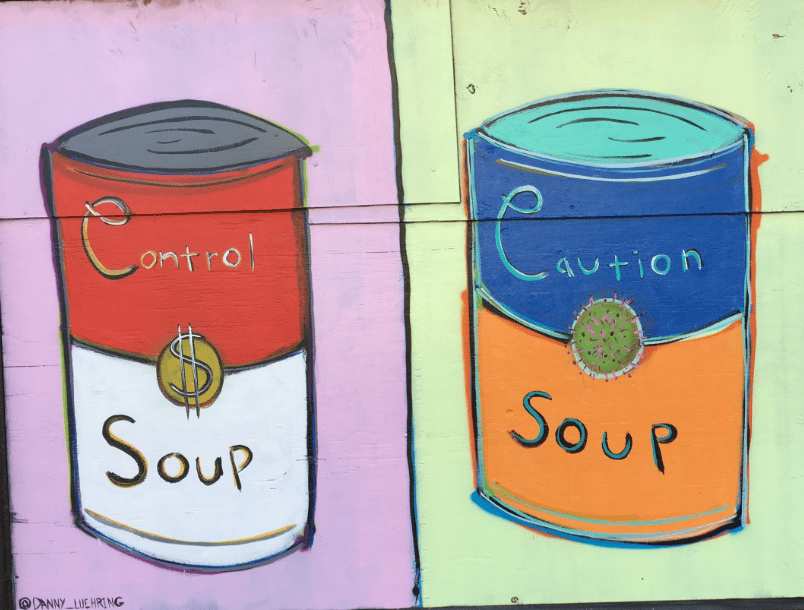 Ever have a well-meaning, yet perhaps overly controlling or risk-aversive, boss say to you:
Ever have a well-meaning, yet perhaps overly controlling or risk-aversive, boss say to you:
-
Our fundraising letter must be no longer than one page.
-
That’s too simple; we don’t want to talk down to our donors.
-
We need to say more about our accomplishments.
-
We need to describe numbers of people served; that’s what’s impressive.
-
That’s not how I talk.
-
That’s not our corporate style.
-
That’s not how we do things.
-
That’s not what our donors are used to.
-
That’s not proper grammar.
-
That’s too gushy and effusive.
-
I want happy, not sad, photos.
-
Asking the reader to “please give generously” is sufficient; no need to name an amount.
-
Asking once is enough.
-
The development director should sign the letter.
-
Signatures from both the E.D. and board president will be more persuasive.
-
We don’t need a P.S.
Alas, these are common fundraising appeal fallacies that will cost you money. Money donors might have given to you, if you’d only understood some fundamental fundraising truths.
Truths, Not Fallacies
I was reminded of some of these truths in a post from Jeff Brooks. He spoke of true pearls of wisdom gleaned from his fundraising mentor, the pioneering direct mail writer Bob Screen. We’ve lost Bob and several fundraising giants in recent years, including Simone Joyaux and John Haydon, but we should never lose sight of the wisdom they imparted. It’s the best way to assure their memories live on and their good works continue.
I did not know Bob, but I’m sure I learned from him without realizing it. Because the good stuff gets passed around. Why? Because it works.
And it takes someone with experience to not just demonstrate it works, but to forcefully maintain the necessity of adhering to tested principles, facts and truth. Even – especially – in the face of doubters (e.g. executive directors; board presidents) who would seriously derail your fundraising efforts. With all good intention, of course.
YOU are the fundraiser.
Never forget this is why you were hired. No one is an expert at everything. And chances are fundraising writing is not your leadership’s key area of proficiency. It’s your job to know what works, and what doesn’t. And one of the best places to learn is from an expert like Bob Screen. Jeff shared, in particular, these lessons:
-
You are not the donor.
-
Writing in a way you find persuasive is not a dependable strategy.
-
Get outside of your own head.
-
Offer!
-
Always have a specific, compelling, simple call to action for your donors.
-
Write with energy. If you want to get through with your message, no project is ever “routine.”
Let’s look at why these truly are fundamentals of effective fundraising writing.
Fundraising Appeal Writing Fundamentals
1. You are not the donor.
Never assume you know what the donor cares about. Or what would motivate them to give. Rather, pay attention to what they say. When we write without thinking about or using our donors’ words, we tend towards braggadocio. We use lots of data to boast about how many people we serve, how we’re the biggest and best, and so forth. Do you enjoy it when people just talk on and on about themselves and how great they are? That’s the opposite of donor-centered communication.
ACTION TIP: Ask donors to share one word that best describes your organization from their perspective. You can do this on your direct mail remit piece or on your online donation landing page. Or include it in a survey, ask for responses via social media, or simply ask folks to reply to an email. Tally up the responses, and see what words are most often reported. Now you know what words to incorporate into your appeal to make it relatable.
2. Writing in a way you find persuasive is not a dependable strategy.
Don’t write to yourself, your executive director or board president. You’re “insiders,” so what persuades you will likely be different than what persuades someone who knows very little about you. And, remember, even your loyal donors don’t live and breathe your work like you do. They have their own needs, and it behooves you to get inside their heads. Don’t guess!
The trend is moving towards segmenting lists more by how people self-identify. This may be as members of a particular giving club, as cat vs. dog donors, as fighters for justice, as arts aficionados, as moral or religious, or even as a friend of one of your insiders. You may find different segments of donors have distinct traits, and may therefore want to approach them differently.
ACTION TIP: Ask your donors about themselves. This has a side donor cultivation benefit, demonstrating you care about what your supporters think and feel. Just make sure you listen, and reflect this back to them. Create a mailed survey or pick up the phone to get answers to your questions. You could try randomly calling subsets of donors with different connections to you and interviewing them (e.g., (1) call 10 major donors; (2) call 10 mid-level donors; (3) call 10 new donors; (4) call 10 monthly donors; (5) call 10 lapsed donors; (6) call 10 event donors; (7) call 10 non-donor direct service volunteers. Design questions so you can better understand your donors’ values and what drew them/keeps them engaged with you. Open-ended questions give you the most qualitative information. For example:
— Why did you first give here?
— Why do you continue giving here?
— What do you like most about what we do?
— What do you like most about the information you receive in our newsletter/blog?
— What do you wish we did more of?
3. Get outside of your own head.
Once you have actual feedback from your audiences, you can begin to wrap your brain around what’s in their heads, not yours. You may be surprised. One faith-based organization I worked with found out donors didn’t care so much about the religion as much as the values underlying the faith. A community center found their assumption donors cared more about arts programs and classes than gym and athletic programs turned out to be precisely wrong. And an arts organization found their small size was perceived as a positive, with the word “intimate” showing up again and again.
ACTION TIP: Create a word cloud to find what adjectives and nouns stand out. Here are two examples. One I generated for a social services agency where we asked donors to submit one word on a remit envelope. It shows donors value not just the fact services are delivered, but that they’re offered in a caring, compassionate, helpful, present and supportive manner. Some value the effectiveness of the organization, which argues for sharing a success story. Others see the mission as necessary and miraculous.
 The other is a cloud generated from Yelp reviews from people who attended plays at the aforementioned arts organization. You’ll notice people value the intimacy. They also value how the experience makes them feel. And just as a bonus, folks prefer “theater” spelled the American way over the British way. This information is gold if you’re sitting down to write your appeal.
The other is a cloud generated from Yelp reviews from people who attended plays at the aforementioned arts organization. You’ll notice people value the intimacy. They also value how the experience makes them feel. And just as a bonus, folks prefer “theater” spelled the American way over the British way. This information is gold if you’re sitting down to write your appeal.
 4. Offer!
4. Offer!
Think of the offer as something terrific your donor won’t be able to refuse. It’s an opportunity for them to express their values, and do something really wonderful they wouldn’t have been able to do on their own. And, importantly, it’s what you want them to do.
ACTION TIP: Include these four essential offer components:
- Describe a compelling problem your donor will consider relevant. It must be human-sized and realistically capable of being solved. For example, don’t ask donors to raise the level of the ocean. That’s too hard. Break the problem down into something they can visualize, like raising the level of water in a drought-stricken reservoir.
- Describe a credible solution. People shouldn’t need a Ph.D. to understand the solution you’re asking them to help with. And don’t rely on folks trusting your word on it. Make the solution easy to understand and believe. People know they can’t meaningfully raise the level of the ocean by peeing in it. So why try?
- Put a price tag on it. The donor will feel differently giving you $100 if your goal is $1,000 than if your goal is $1 million. Or amorphous. As you’re writing, think about responding to this question: “If I give you $100, what will you do with it and how much will it help?” You will want to have different ask amounts for donors at different giving levels. One size does not fit all.
- Create urgency. Donors need a reason to give now. Without this, they just may give to someone else who seems to need their support more. Or they’ll put your appeal away “for later” – which often never comes. You need to strike while the iron is hot! There are numerous ways to create urgency, including an actual emergency, a need to keep doors open, a need to support folks during something season (e.g. a holiday or winter weather), or a matching grant.
5. Always have a specific, compelling, simple call to action for your donors.
Think about the single, most important thing (SMIT) you need to communicate; then tie your opening to your reason for writing as quickly as possible. It may be only thing your prospect will read before deciding whether or not to continue reading, or simply toss you into trash.
Ask early and often. Readers skim appeal letters, and you never know where their eyes will land. It’s good to be repetitive with your SMITs; nothing is more important than the ask. In a two-page letter (for current donors; I tend towards 4-page for donor acquisition) I’ll ask three times.
Offer multiple ways to give (e.g., via remit piece and envelope; link to your website; telephone number). Having a specific call to action, absent a user-friendly way to follow through, is a cardinal sin.
ACTION TIP re SMIT: Make your offer explicit. Spell out the reason for your ask in black and white, even before you make your ask. Force a decision with an introduction that triggers an “I’ll help/I won’t help” decision.
- Every morning Jim dreams of getting onto a basketball court again. But his war injury means this will never happen. Unless you help.
- Isabelle dreams of being 1stin her family to go to college and ‘make something of herself.’ Instead she’ll probably get a minimum wage job right out of high school. Unless you help.
ACTION TIP re ask placement:
- Make the first ask general, towards the beginning of the letter (e.g., “You can rescue a puppy today.”)
- Make the second ask specific, using an amount or range of giving possibilities (e.g., “Will you give $60 a month to provide a puppy with food, medical care, emotional support and a comfy bed?”)
- Make the third ask in the P.S. to reinforce your SMIT (e.g., Remember, your gift of $15, $30, $60 or $90 a month will give a dog who’s experienced trauma a good home.”)
ACTION TIP re ways to give:
- Include your mailing address on your website donation page in case donors prefer to send a check.
- Include your tax identification number in case the donor wishes to recommend a gift from their Donor Advised Fund.
- Make branded giving pages user-friendly and mobile responsive.
- Assure the landing pages include a campaign-specific call to action so donors know they’re in the right place. Begin with “YES! I’ll help _________.” This seals the deal and helps the donor feel secure, and even warm and fuzzy, about their decision to help.
6. Write with energy. If you want to get through with your message, no project is ever “routine.”
However you feel when you sit down to write is how your readers will feel when they sit down to read. Don’t phone it in. Don’t just take last year’s letter and recycle. Becoming a writer is about being conscious.
ACTION TIP: First think about what inspires you about your mission. Dig down deep to renew your passion. Get into the field to experience your work first-hand. Review what your donors have expressed about why they give. Now sit down at your desk, put a smile on your face and begin to write what you’re feeling!
Want More Help Writing Your Appeal?
 Grab my Anatomy of a Fundraising Appeal + Sample Template. It includes all the elements that make an appeal — any appeal — successful. Writing a compelling fundraising letter can be tricky. It’s not the same kind of writing as a brochure, annual report or grant proposal. But it’s not rocket science – it’s something you can easily learn. It’s just not something most of us are taught.
Grab my Anatomy of a Fundraising Appeal + Sample Template. It includes all the elements that make an appeal — any appeal — successful. Writing a compelling fundraising letter can be tricky. It’s not the same kind of writing as a brochure, annual report or grant proposal. But it’s not rocket science – it’s something you can easily learn. It’s just not something most of us are taught.
If you follow these guidelines, you’ll raise more money.
Not satisfied? All Clairification products come with a 30-day, no-questions-asked, 100% refund guarantee. The only way you lose? You got it — it’s by not trying. This is a great time to learn something new!
Image is from street art painted over boarded up stores in San Francisco during the pandemic.
#Fundraising #Appeal #Fallacies #Cost #Money








